State of the Budgie: 2023 In Review and Goals for 2024
2023 was an amazing year for Budgie Desktop and our organization. Time to dive into our State of the Budgie to recap our efforts in 2023 and the goals for 2024.
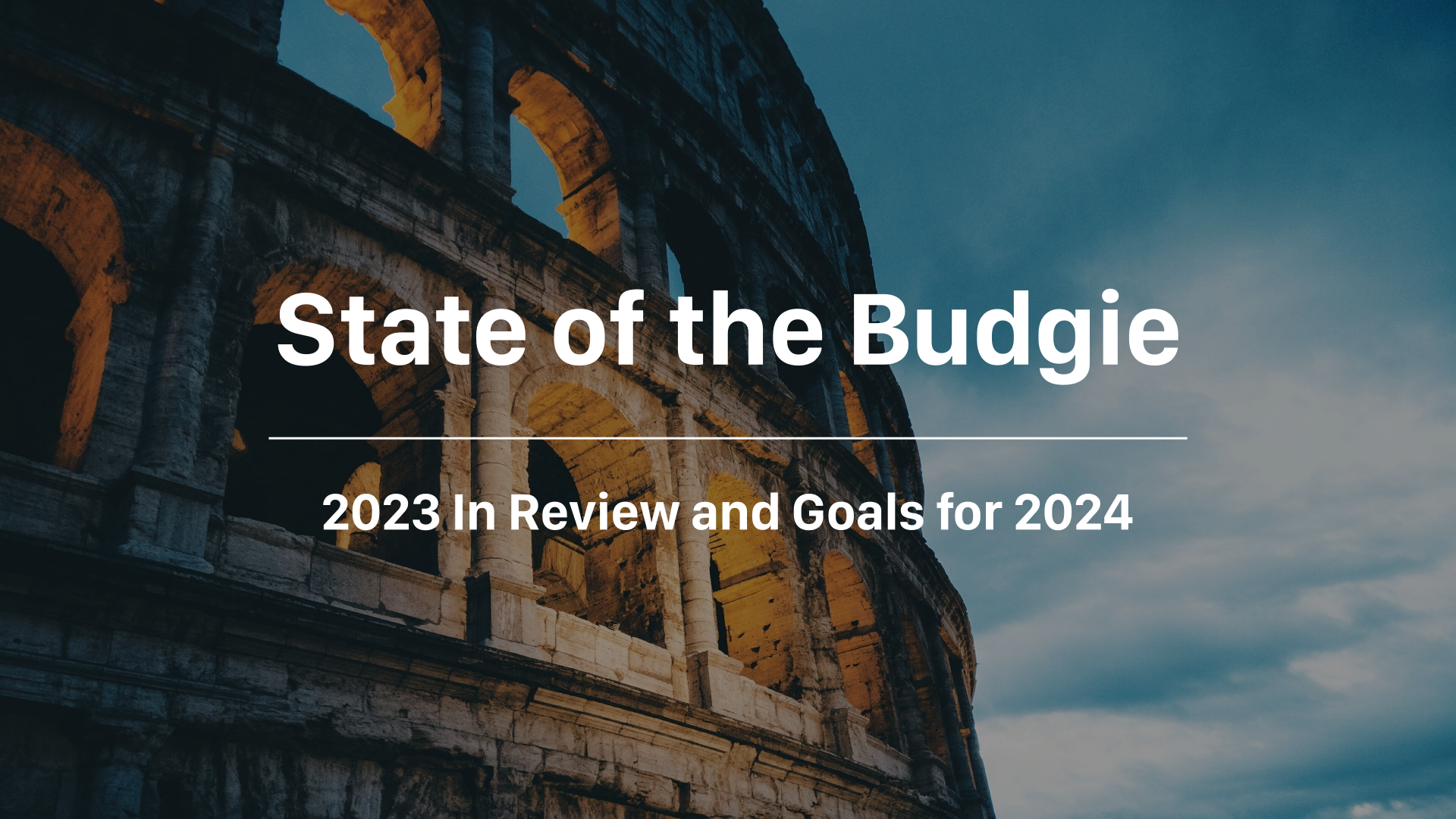
2023
2023's theme was centered around our "User-centric" organization value. We focused on this value in a couple important ways:- Delivering major new features and architectural improvements across Budgie 10.7 and 10.8 releases.
- Improving stability and UX consistency with bug fixes and new components such as Magpie (our fork of Mutter 43.x).
Budgie 10
Budgie Desktop saw a total of 6 releases of Budgie 10.x throughout 2023. We kicked off the year with Budgie 10.7 in January, with bug fixes and QoL improvements in February and April. In August, we released Budgie 10.8 and followed up with two bug fix releases in 10.8 series in October. The rest of the year was focused on porting various components from using libwnck directly to libxfce4windowing for Wayland support and of course some much deserved rest for the holidays! While I will refrain from exhaustively writing about all the amazing work that has gone into those releases (or else this will turn into the Odyssey by Homer), we will highlight some areas, with snippets from the respective blog posts.New Features
Budgie Menu
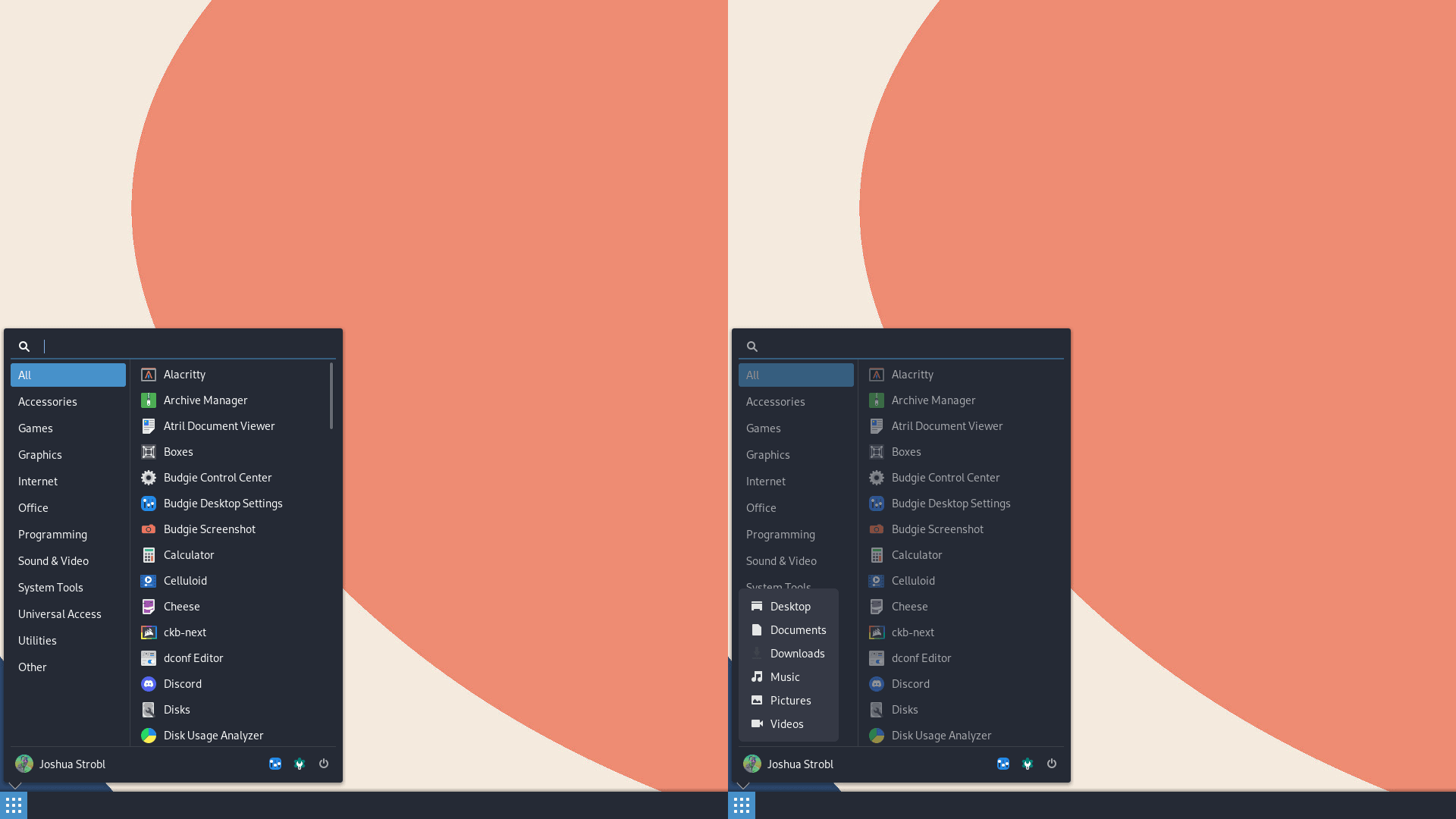
- Dual-GPU Support via switcheroo-control integration. Users with dual-GPU setups are able to launch their applications without necessarily having to worry about which GPU is in use and manually switching between them.
- Personal User Menu with quick XDG directory access. This feature enabled the ability to open up a file manager directly to folders like Home, Documents, Music, etc.
- Easier access to Budgie Desktop Settings and Budgie Control Center. This one is pretty self-explanatory, right?
Budgie Screenshot
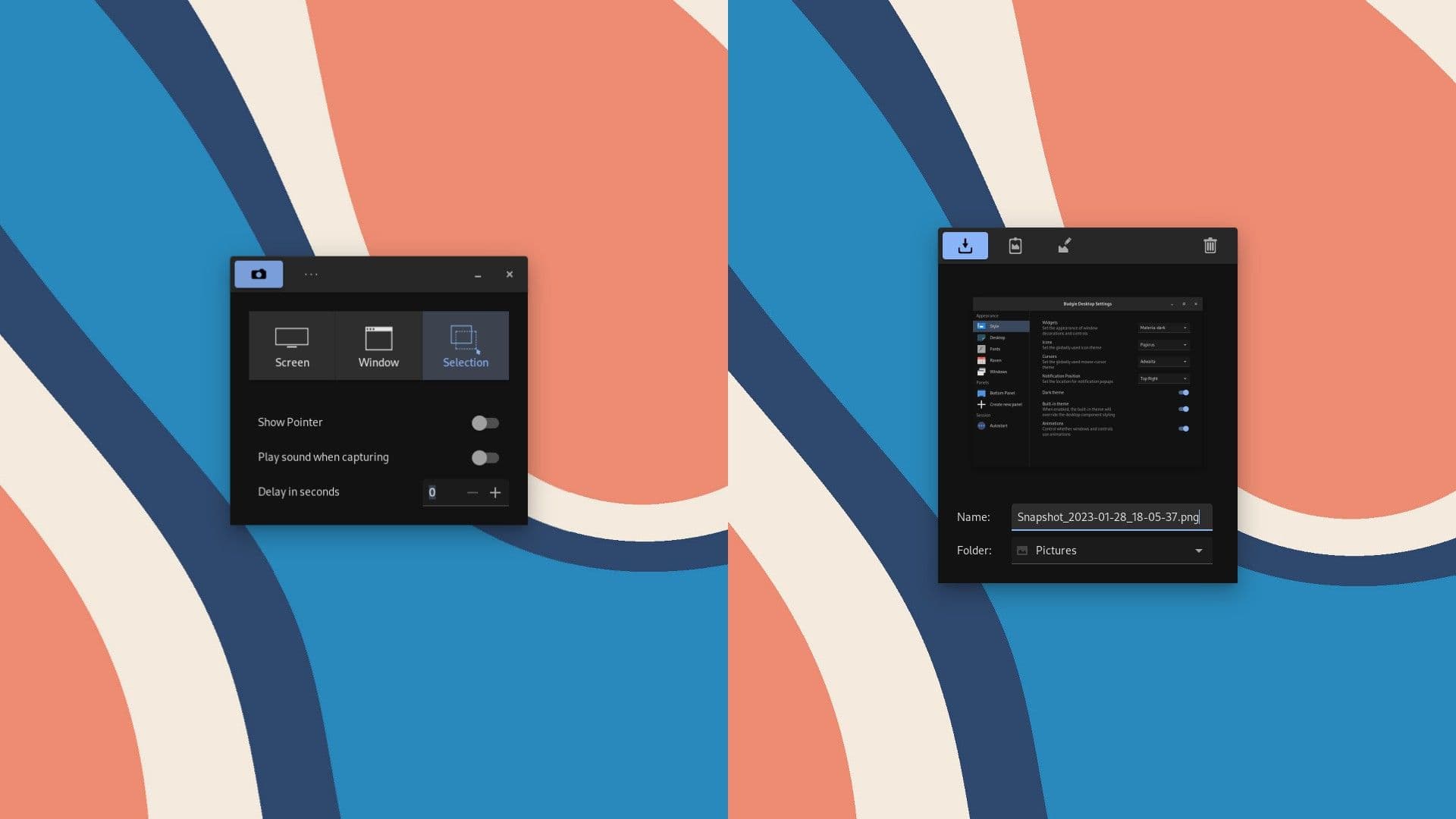
Budgie Desktop Settings
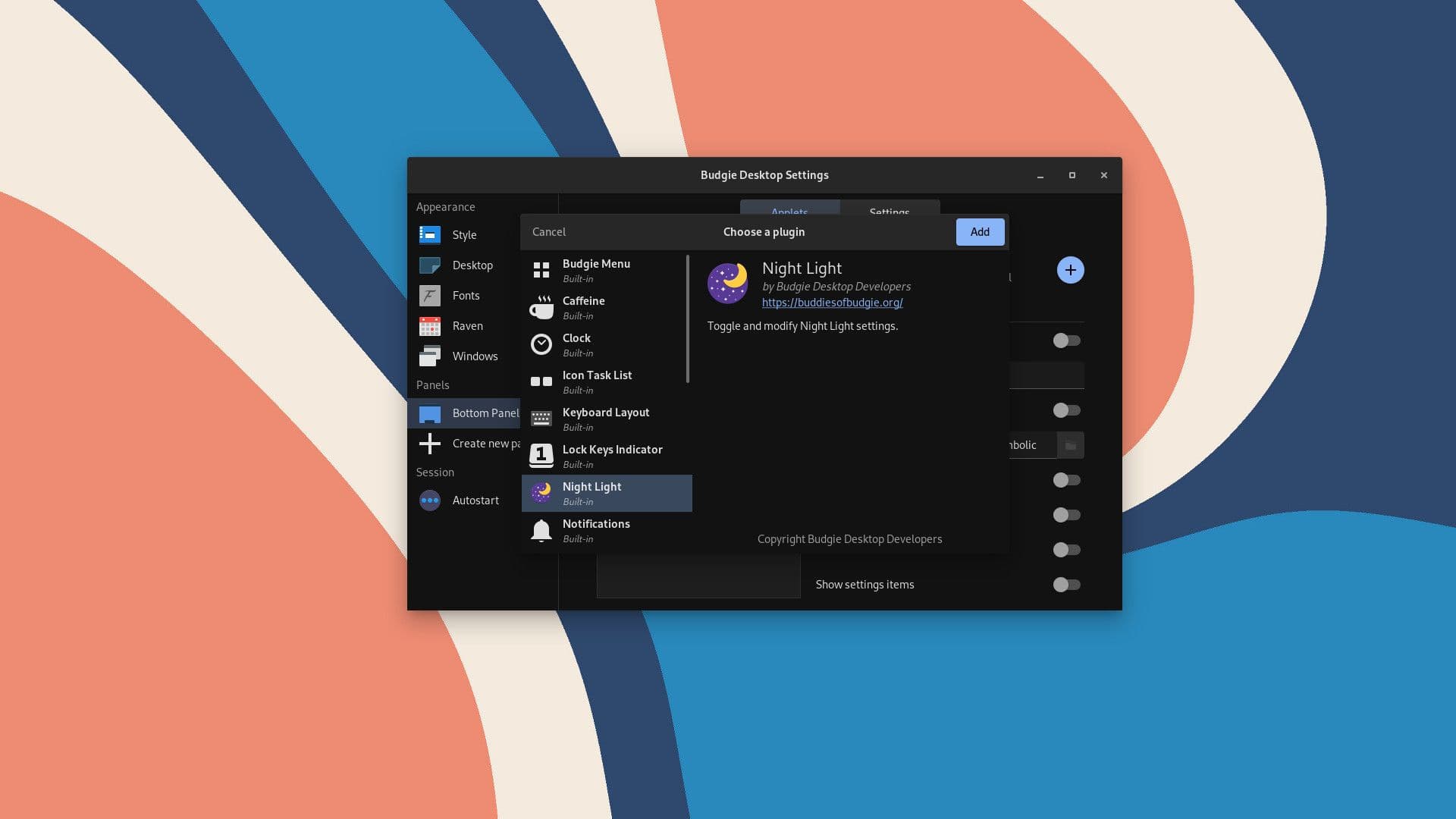
Notifications
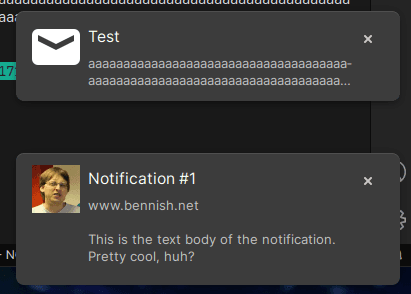
- Experience
- Spec Compliance & Control Center Integration
- General Fixes
- Notifications fade in and out upon showing / closing rather than just popping into view.
- When a window leaves fullscreen mode, a notification popup will be shown to alert the user that there are notifications that they didn't see.
- Refinement to body text in the form of width chars for consistent minimum and maximum size per line, so the entire popup body is filled by the label.
- Improved text wrapping.
- Improvements were made in support of the FreeDesktop Notification spec, specifically support for notification sounds was introduced. As not all applications will be displayed currently in Budgie Control Center and some applications such as Element and Discord have separate capabilities to play notifications sounds, we do not have sounds enabled by default.
- The "Show Message Content in Popups" option in Budgie Control Center's Notification panel is respected.
- We have refined how long notifications are displayed for those applications that don't set their expiry time. Since persistence is done by Raven, not the notification server, we set a different minimum show time for the popups to ensure that one is actually shown when it should be. This provides a more consistent notification display management.
- Prevented notification popups from stealing input focus.
- Notifications should no longer cause screen flickering when in a fullscreen application.
Raven
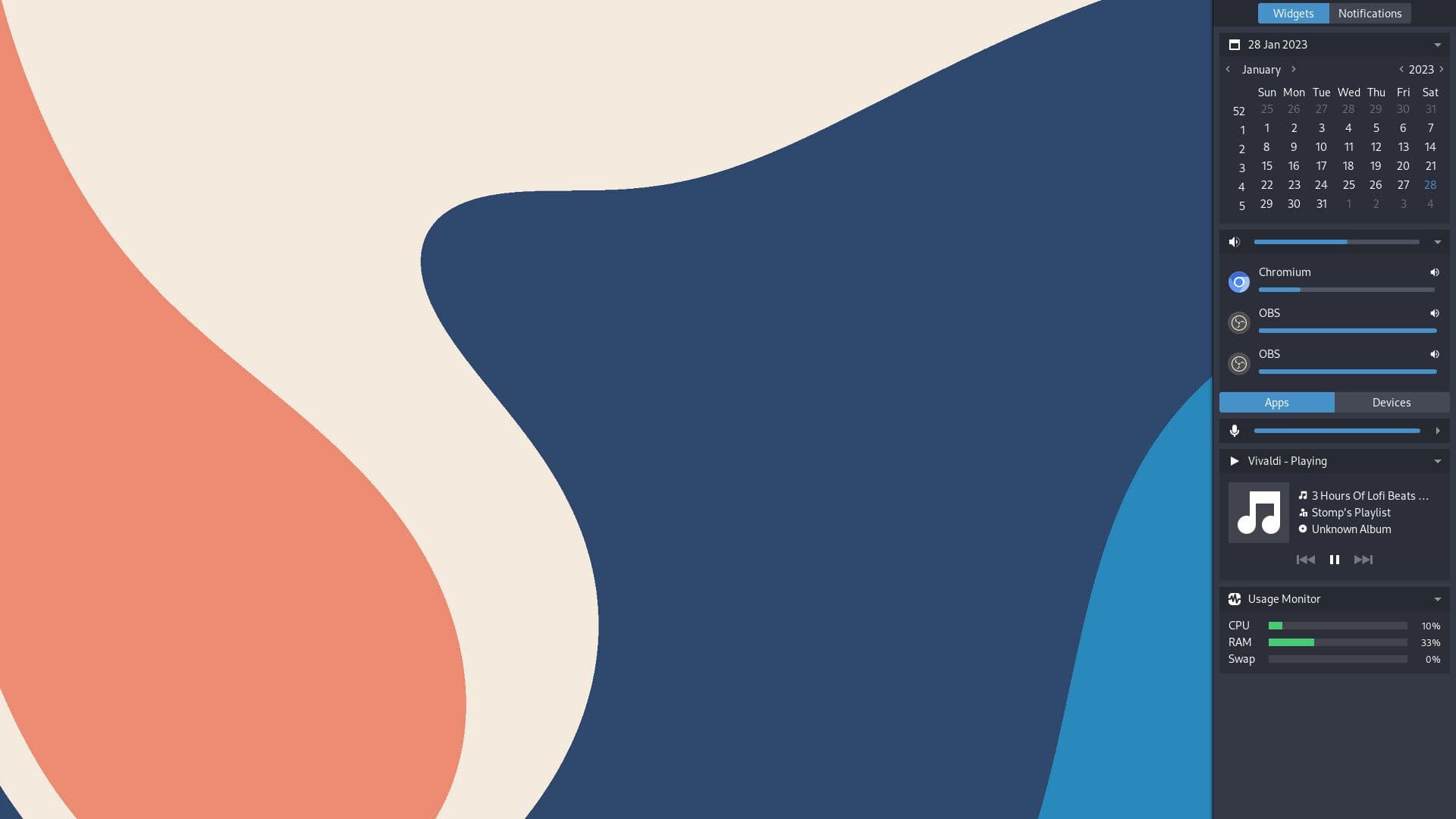
- It was re-architected with a brand new pluggable Raven widget API system, enabling third-party widget development.
- Updated design for existing widgets and widget ordering capability.
- New Usage Monitor widget for CPU, RAM, and Swap usage.
Re-architecture & Widget API
Similar to our Budgie Panel widget API, the Raven Widget API leverages libpeas to provide support for writing plugins in C, Python, and Vala. These widgets will automatically show up in Budgie Desktop Settings. As a result of this re-architecture around Raven and leveraging past work on the panel widget plugin API, Raven widgets can be positioned to your heart's content and you can even remove the ones you do not want. All of the widgets that ship with Budgie Desktop leverage the same plugin architecture as third-party ones will.Updated Design
While we made these changes, we took the opportunity to refresh the widgets:- The Media Player widget has a more compact design.
- Widget header icons for sound output and input are interactive and will mute the respective device.
- Day names in the Calendar widget can be turned off.
- Power strip, which was disabled clear back in 10.5, was finally removed in favor of our Power Dialog and more accessible power options in Budgie Menu.
Power Dialog
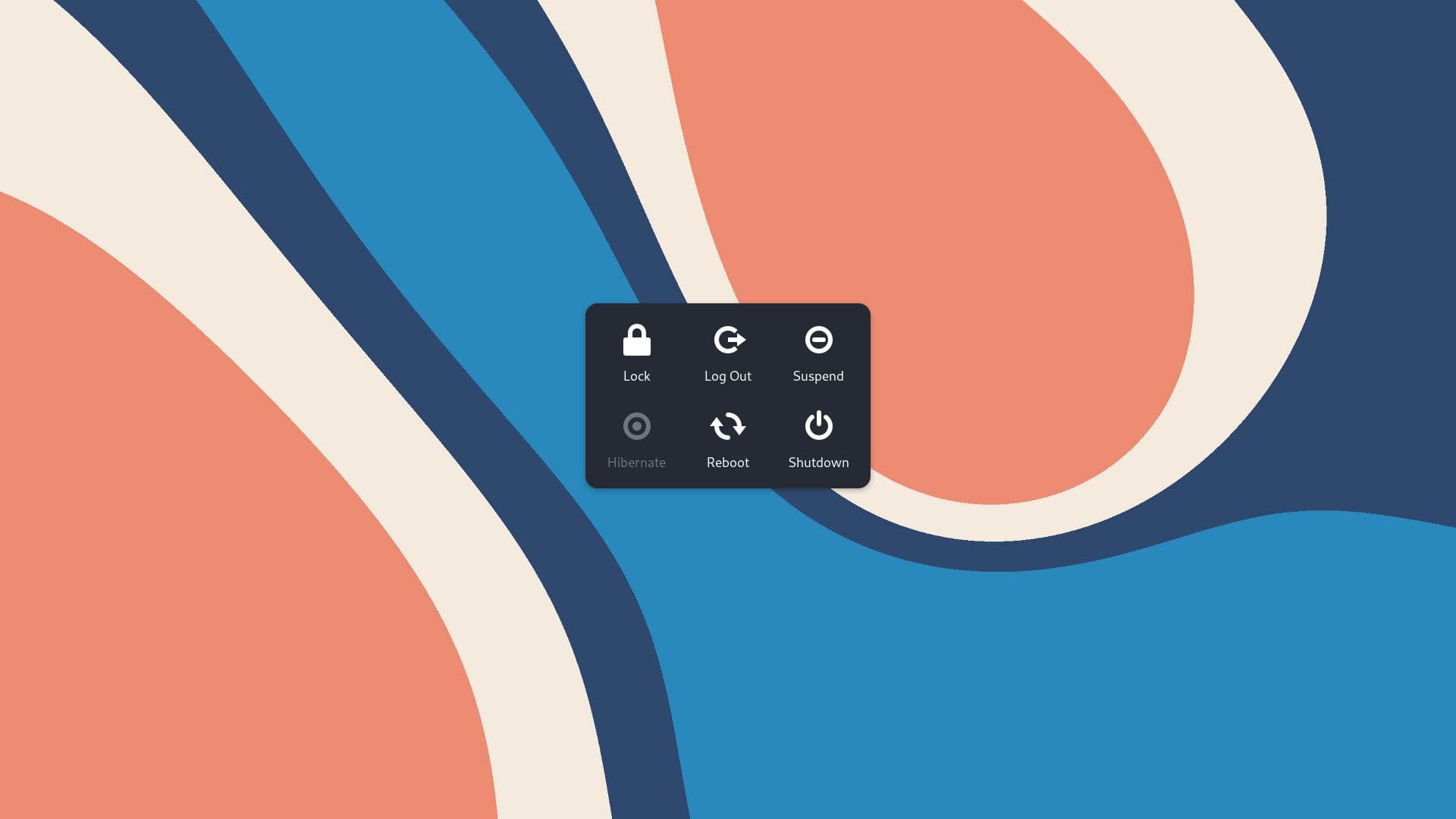
Other
Here are some other smaller improvements sprinkled across the year:- IconTasklist scaling for icons was introduced, enabling dynamic scaling for smaller and larger panel sizes alike while retaining desirable icon sizes for panels in "Dock mode".
- The previously third-party Budgie Trash Applet, developed by Buddies of Budgie team member Evan Maddock (EbonJaeger), was merged into mainline Budgie in 10.8.
- Privilege Escalation Dialogs show the action description and ID so you know what is requesting access.
- power-profiles-daemon support was integrated into our battery indicator, so you can switch between Balanced, Power Saver, and Performance modes depending on device support.
Architectural Improvements
Application Indexer
Budgie 10.7 introduced a new application indexer, replacing our use of libgnome-menus and unifying our logic used in both Budgie Menu and Budgie Run Dialog, for consistency in the applications we show. This indexer is more reliable across a wider variety of directories which are used to store desktop files.Status Notifier Support

na-tray or the XEmbed Protocol for the creation, management, and rendering of trays icons. In Budgie 10.8, our System Tray adopted the Status Notifier specification. This is a modern, vendor-agnostic solution that enables applications to communicate all relevant information for the rendering of their tray icon over DBus rather than being responsible for drawing tray icons and menus themselves, promoting the development of catered solutions by desktop environments and those developing panels for user experiences such as tiling window managers.
The result of this on the Budgie Desktop side is that we can draw all menus and items in a manner that is visually consistent. Going into Budgie 11, we will have a similar solution and paired with multiple panels across multiple monitors (a requirement for Budgie 11); you will even be able to have multiple tray applet instances enabled, which was not otherwise possible with the XEmbed-based solutions.
Magpie v0.x
During our announcement post related to our Wayland plans, we further announced our Budgie-specific fork of Mutter as it was in GNOME 43. The goal of this was to address regressions that were, understandably, incrementally introduced into Mutter related to X11 support. These regressions created a wide-range of issues for users and it was determined that our engineering time would be best spent focusing on Wayland rather than fixing up X11-specific bugs and updating Budgie to support new Mutter ABI changes. Magpie v0.x provides us a stable ABI that can be leveraged across multiple GNOME Stack releases until Magpie 1.0 (built on wlroots) is released. Budgie 10.8 was the first release to start requiring Magpie v0.x and the result has been a more consistent and reliable experience for our users.Wayland efforts
While our goal in 2023 was only to start experimenting with Wayland compositors and to take the learnings from those experiments to apply to a "future Budgie WM compositor" built for Budgie 11, we made a significant shift in our development focus starting middle of last year to accelerate our Wayland plans and work towards Budgie 10 being Wayland-only (and continuing to be Wayland-only going into Budgie 11). This was in recognition of several major developments in the broader ecosystem that we covered in our Wayland post. In that lengthy post, we covered our experiences at that point with wlroots as well as XFCE's libxfce4windowing library, which provides us a library which supports both X11 (via libwnck) and Wayland (various Wayland protocols) at the same time. This is especially useful as we iterate on making Budgie Wayland-compatible while using it at the same time. I am happy to report that progress on Wayland support has been steady on all fronts since our shift in development focus to it. In Budgie Desktop, several applets and UX components of Budgie Desktop have been ported over or are in the process of being ported:- Show Desktop Applet has been ported
- Tab Switcher has been ported
- Workspaces Applet has been ported
- IconTasklist Applet is currently being ported
2024
For the new year, our focus is on two "epics".Budgie 10 Epic
Our main epic is delivering Budgie 10 on Wayland. This does not necessarily mean everything will be feature complete, as we still need to finesse, research and define what else needs to be done. Our aim though is to ensure our first release can be daily driven and consumed. For Q1, our focus will be:- Delivering Budgie 10.9 (as early as this month) featuring our initial work with libxfce4windowing, as well as our new requirement for using budgie-session for launching Budgie Desktop. This will include the existing applets and Tab Switcher that have been ported and should provide plenty of time for distribution packagers to get Budgie Desktop into their respective releases without running up against any freeze deadlines.
- Expand on various definitions of work for the year related to Budgie 10 in the areas of: daemon and xdg / flatpak portal.
- Getting Budgie Desktop running in a Wayland or XWayland session for better testing.
- Early daemon development work that was deferred last year. Some of this work will be done for the purposes of bridging the existing Budgie Control Center and Magpie v1.
- Round out any remaining Wayland work in Budgie Control Center and Budgie Desktop specifically so it should be usable under Magpie v1.
- Begin any portal work defined in Q1.
Budgie 11 Epic
Our secondary epic is Budgie 11 development, with focus on building out key components such as the daemon, early panel and applet functionality, and a new Budgie Control Center. This work will be spread out across the year, with most of the focus before putting Budgie 10 into maintenance mode being related to Magpie and the daemon. There may be porting work done on components in Budgie Desktop's microcosm like Budgie Desktop View, or even smaller components used in Budgie 10 itself depending on how cohesive an experience we can make it, but realistically most of the UX focus will gravitate towards the end of the year and center around early panel and Control Center developments so the team can start "dogfooding" Budgie 11 as soon as possible.In Summary
It has been really incredible to see all that we have accomplished in 2023, with new contributors, new users, and new operating systems delivering Budgie Desktop. Huge thanks to the team and community for constantly improving on Budgie. 2024 is going to be a really exciting year for Budgie Desktop too! The first time we all experience Budgie running under Wayland is going to be a real highlight. We should be putting ourselves in a position where we can finally close the exceedingly long chapter of Budgie 10 development efforts and focus on the next chapter of Budgie Desktop. We are going to learn a lot on our journey developing Budgie 11. With your help, the Buddies of Budgie community will continue to grow and engage with other projects.Supporting The Project
Did you know that you can financially support the Buddies of Budgie project? Buddies of Budgie was founded to provide a home for Budgie Desktop and your financial contribution can go a long way to supporting our goals for development, providing opportunities for financial compensation, leveraging no-compromise Continuous Integration and Continuous Delivery systems for streamlining Budgie 10 and 11 development, and more
